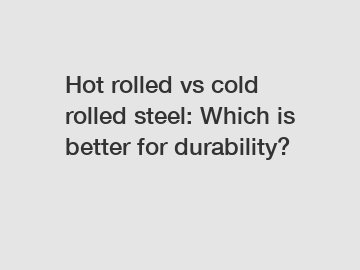Apr. 05, 2024
When it comes to choosing between hot rolled and cold rolled steel for durability, there are several factors to consider. Both processes have their advantages and disadvantages, so it's essential to understand the differences to make an informed decision. In this article, we will compare hot rolled and cold rolled steel, exploring which option may be better for durability in various applications.
**Hot Rolled Steel**.
Hot rolled steel is processed at a high temperature, typically above 1700 degrees Fahrenheit. This allows the steel to be more malleable and easier to shape. The process involves passing the steel through a series of rollers to achieve the desired thickness. Hot rolled steel tends to have a rough surface finish due to the high temperature at which it is processed.

One of the main advantages of hot rolled steel is its cost-effectiveness. The process is relatively quick and efficient, making it a more economical option for large-scale production. Hot rolled steel is also ideal for applications where precise dimensions are not critical, as the final product may have slight variations in size.
**Cold Rolled Steel**.
Cold rolled steel, on the other hand, is processed at room temperature. This results in a smoother surface finish and tighter tolerances compared to hot rolled steel. The cold rolling process involves passing the steel through rollers at room temperature to achieve the desired thickness and shape. Cold rolled steel is generally stronger and harder than hot rolled steel.
One of the main advantages of cold rolled steel is its superior surface finish. The smooth surface makes it ideal for applications where aesthetics are important, such as in the automotive industry or architectural applications. Cold rolled steel also has more uniform mechanical properties, making it suitable for applications that require precise dimensions and consistent performance.
Suggested reading:**Durability Comparison**.
In terms of durability, both hot rolled and cold rolled steel have their strengths. Hot rolled steel is more ductile and suitable for applications that require extensive forming or bending. However, the rough surface finish of hot rolled steel may be more prone to corrosion over time, especially in harsh environments.
Cold rolled steel, with its smoother surface finish and tighter tolerances, is generally more resistant to corrosion and wear. This makes it a better choice for applications where durability is a primary concern, such as in machinery, appliances, or structural components. Cold rolled steel is also more dimensionally stable, making it less likely to warp or distort under stress.
**Conclusion**.
In conclusion, the choice between hot rolled and cold rolled steel for durability depends on the specific requirements of the application. Hot rolled steel may be more cost-effective and suitable for applications that require extensive shaping, while cold rolled steel offers superior surface finish and dimensional stability for applications that demand high durability. Ultimately, it is essential to consider the specific needs of the project when choosing between the two options.
If you have any further questions about hot rolled vs cold rolled steel or would like to discuss your specific requirements, please feel free to contact us.
Contact us to discuss your requirements of cold rolled steel vs hot rolled steel, wire rod industrial quality, how are steel coils processed. Our experienced sales team can help you identify the options that best suit your needs.
Suggested reading:Previous: Galvannealed vs Galvanized: Which Rust-Resistant Coating Reigns Supreme?
Next: Cold rolled steel vs hot rolled steel: Which is more cost-effective for industrial projects?
Related Articles
If you are interested in sending in a Guest Blogger Submission,welcome to write for us!
All Comments ( 0 )